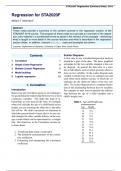BIOL 1218 Lab Notes 2
Property Lab Part 2
LAB 3: THE CARBON CYCLE
DATE: January 26, 2022
What is primary production?
the chemical energy generated by photosynthetic organisms (photoautotrophs)
the source of energy for all organisms — the foundation upon all ecosystems are built
energy is derived from the fixation of carbon during photosynthesis
represents a crucial energy transformation — the conversion of light energy from the sun into chemical energy that can be used
by living organisms
How is chemical energy generated by photoautotrophs stored? What is its significance?
stored as carbon compounds
carbon is one measure of primary production
plant biomass is ~50% carbon, we can use that as an estimate for measuring the amount of primary production done
What is GPP?
gross primary productivity
the total amount of carbon fixed by photoautotrophs
GPP is equivalent to all photosynthesis done by plants in the area
How much solar energy can plants convert into chemical energy?
less than 1% of the available solar energy
BIOL 1218 Lab Notes 2 1
, What is cellular respiration?
process whereby energy stored in the chemical bonds of carbohydrates is transferred to the chemical bonds of the molecule ATP
ATP — the “energy currency” in our bodies
supports metabolism and growth in organisms
most eukaryotic organisms carry out cellular respiration
all plant tissues lose carbon through respiration
uses ~50% of the carbon it generates from photosynthesis to power itself via cellular respiration
What is NPP?
net primary productivity
🌟 NPP = GPP - respiration
NPP represents the biomass gained by the plant — therefore, the amount of plant material (and carbon) available for herbivores
to consume
ACTIVITY 2 needs to be completed
Procedure
Week 1: Jan 30th (DID THIS LAST WEEK)
Randomly assign the six pots to one of three treatments: “Week 1”, “Week 2 Light” , and “Week 2 Dark” (2 pots per treatment).
Week 1 treatment: cut the grass above the soil line from 2 pots. Weigh and record the cut plant material from each pot (Week 1
Grass Wet Weight). Place the plant material from each pot into separate envelopes, label (group member names, treatment
and lab section) and give to your lab instructor to dry.
Week 2 Light treatment: leave 2 pots untouched, allow to grow for one week
Week 2 Dark treatment: these 2 pots will be grown in the dark so that no light reaches the plants, allow to grow for one week.
Week 2: Feb 6th (START HERE)
Describe appearance of the plants. Cut the grass above the soil line from the two Light pots. Weigh the cut plant material and
record these data (Week 2 Grass Light Wet Weight). Place in envelopes, label (group member names, treatment and lab
section) and give to your lab instructor to dry.
Describe appearance of the plants. Cut the grass above the soil line from the two Dark pots. Weigh the cut plant material and
record these data (Week 2 Grass Dark Wet Weight). Place in envelopes, label (group member names, treatment and lab
section) and give to your lab instructor to dry.
Week 3: Feb 13th
Weigh Week 1 Grass that has been dried (Week 1 Grass Dry Weight)
Weigh Week 2 Dark Grass that has been dried (Week 2 Dark Grass Dry Weight)
Weigh Week 2 Light Grass that has been dried (Week 2 Light Grass Dry Weight)
Week 1 Pot 1 weight — 5.43 g
Week 1 Pot 2 weight — 5.82 g
Calculations:
Week 2 Light Grass Dry Weight — Week 1 Grass Dry Weight = NET PRODUCTIVITY
4.90-0.45 =
4.00-0.39 =
BIOL 1218 Lab Notes 2 2











